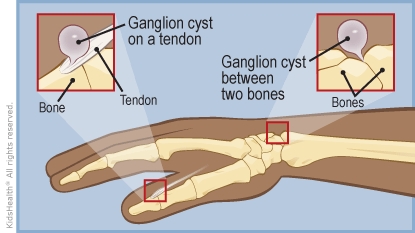Ganglion Cyst: How to Care for Your Child
A ganglion cyst is a fluid-filled lump or swelling that forms on a joint or in its surrounding tissues. It is not harmful and usually goes away without treatment within about a year.


A ganglion cyst is a fluid-filled sac containing a jelly-like fluid that can form in any joint. It can form when the fluid that cushions a joint or tendon leaks into the surrounding area and a thin wall forms around it. The exact way that all ganglion cysts develop is not clear but injury or stress on the joint may play a role.
Ganglion cysts occur most commonly on the back of the wrist. Although they may happen at any age, they are most commonly seen in young adults, especially women.
The health care provider can usually make the diagnosis of ganglion cyst by examining your child. Since most ganglion cysts in children go away on their own, your health care providermay recommend that you wait and see if the cyst goes away without treatment.
Occasionally the cyst may become painful or cause trouble with movement of the joint and the health care provider might recommend a wrist brace for comfort. Sometimes, draining fluid from the cyst or surgery is necessary. Ganglion cysts can return, even after drainage or surgery.

-
For some kids, activities like playing video games, using computers, and participating in sports may make the ganglion cyst worse and should be limited.
-
Tell your child not to push on or hit the cyst.
-
Keep any follow-up appointments as directed by your health care provider.

